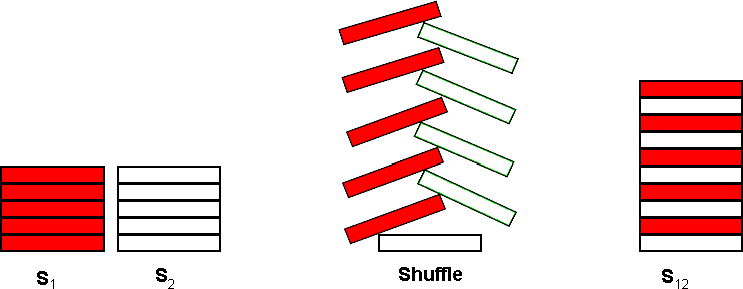Shuffle'm Up(POJ--3087
来源:互联网 发布:java构建工具 知乎 编辑:程序博客网 时间:2024/05/06 19:53
Description
A common pastime for poker players at a poker table is to shuffle stacks of chips. Shuffling chips is performed by starting with two stacks of poker chips, S1 and S2, each stack containing C chips. Each stack may contain chips of several different colors.
The actual shuffle operation is performed by interleaving a chip from S1 with a chip from S2 as shown below for C = 5:

The single resultant stack, S12, contains 2 * C chips. The bottommost chip of S12 is the bottommost chip from S2. On top of that chip, is the bottommost chip from S1. The interleaving process continues taking the 2nd chip from the bottom of S2 and placing that on S12, followed by the 2nd chip from the bottom of S1 and so on until the topmost chip from S1 is placed on top of S12.
After the shuffle operation, S12 is split into 2 new stacks by taking the bottommost C chips from S12 to form a new S1 and the topmost C chips from S12 to form a new S2. The shuffle operation may then be repeated to form a new S12.
For this problem, you will write a program to determine if a particular resultant stack S12 can be formed by shuffling two stacks some number of times.
Input
The first line of input contains a single integer N, (1 ≤ N ≤ 1000) which is the number of datasets that follow.
Each dataset consists of four lines of input. The first line of a dataset specifies an integer C, (1 ≤ C ≤ 100) which is the number of chips in each initial stack (S1 and S2). The second line of each dataset specifies the colors of each of the C chips in stack S1, starting with the bottommost chip. The third line of each dataset specifies the colors of each of the C chips in stack S2 starting with the bottommost chip. Colors are expressed as a single uppercase letter (A through H). There are no blanks or separators between the chip colors. The fourth line of each dataset contains 2 * C uppercase letters (A through H), representing the colors of the desired result of the shuffling of S1 and S2 zero or more times. The bottommost chip’s color is specified first.
Output
Output for each dataset consists of a single line that displays the dataset number (1 though N), a space, and an integer value which is the minimum number of shuffle operations required to get the desired resultant stack. If the desired result can not be reached using the input for the dataset, display the value negative 1 (−1) for the number of shuffle operations.
题意:扑克玩家在玩一种洗牌筹码的游戏,总共有两堆筹码s1和s2,每堆筹码有c个芯片,芯片都是不同的颜色,将s1与s2堆成2*c的筹码,抽取的方式以先抽取s2的最下边的筹码然后再抽取s1的最下边的筹码一次叠加。如果堆成的s12是题目要求的就输出总共操作的次数;如果目前不是要求的筹码,那么就将此时的s12重新分成s1和s2两个部分,以s12的底部c个芯片分为s1,顶部c个芯片分为s2;如果怎么都堆不成要求的筹码,那么就输出-1;
思路:按题意进行模拟即可。
Sample Input
24AHAHHAHAHHAAAAHH3CDECDEEEDDCC
Sample Output
1 22 -1
#include <cstdio>#include <cstring>using namespace std;char answer[400],aa[400],bb[400]; //answer存储要求的筹码,aa存储s1的筹码,bb存储s2的筹码int len,cnt;void BFS(char *a,char *b){ cnt++; //累加操作次数 int i=0,j=0,top=0; char c[400]; while(1) //模拟叠加芯片 { c[top++]=b[i++]; c[top++]=a[j++]; if(top==len*2) break; } c[top]='\0'; //此步不能丢 if(strcmp(c,answer)==0) //如果叠加的筹码已经符合题目要求则输出操作次数 { printf("%d\n",cnt); return ; } strcpy(a,c); //平分s12 a[len]='\0'; strcpy(b,c+len); b[len]='\0'; if(strcmp(a,aa)==0||strcmp(b,bb)==0) //如果平分后的s1和s2与刚开始输入时的s1和s2相等就说明不能叠加出题目要求的筹码,则输出-1 { printf("-1\n"); return ; } BFS(a,b); //如果以上情况都不满足就接着递归 return ;}int main(){ //freopen("lalala.text","r",stdin); int n; char a[400],b[400]; scanf("%d",&n); for(int k=1; k<=n; k++) { cnt=0; scanf("%d",&len); scanf("%s",a); strcpy(aa,a); scanf("%s",b); strcpy(bb,b); scanf("%s",answer); printf("%d ",k); BFS(a,b); } return 0;}- POJ 3087 Shuffle'm Up
- POJ 3087 Shuffle'm Up
- POJ 3087 Shuffle'm Up
- POJ 3087 Shuffle'm Up
- poj 3087 Shuffle'm Up
- POJ 3087 Shuffle'm Up
- POJ 3087 Shuffle'm Up
- POJ 3087Shuffle'm Up
- poj 3087 Shuffle'm Up
- Shuffle'm Up poj 3087
- POJ 3087 Shuffle'm Up
- POJ 3087 Shuffle'm Up
- poj 3087 Shuffle'm Up
- POJ 3087:Shuffle'm Up
- POJ 3087 Shuffle'm Up
- POJ 3087 Shuffle'm Up
- POJ 3087 Shuffle'm Up
- Shuffle'm Up(POJ--3087
- Top 10:HTML5、JavaScript 3D游戏引擎和框架
- 遍布科技公司的“间谍网络”第一时间网罗靠谱创业者
- Camera
- unity插件之TDTK的学习之Editor与Manager(二
- 创业者素质能力的判断是重中之重
- Shuffle'm Up(POJ--3087
- Python编程中常用的12种基础知识总结
- 【effective c++读书笔记】【第7章】模板和泛型编程(1)
- GPS数据解析程序
- 市场推广渠道都有很实用
- 百度排名规则及算法总结
- EularProject 47:具有相同个数因子的连续数字
- 邀请各个领域领军人物组成基金顾问团队
- Cocos2d之Box2d基础知识


